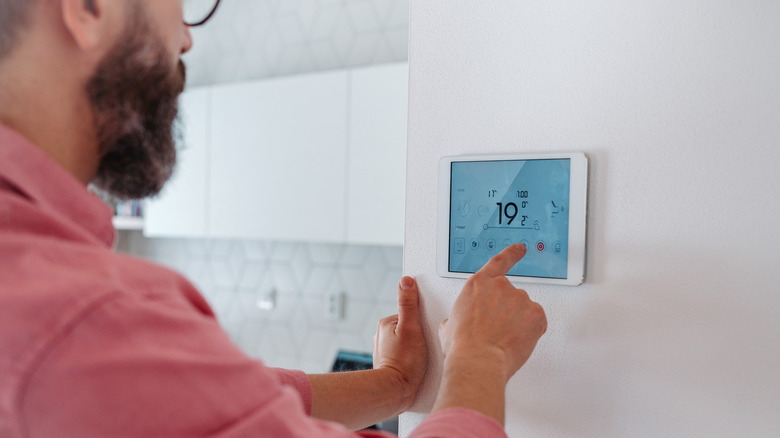Here's What EM Heat On A Thermostat Really Means (& When You Should Use It)
We may receive a commission on purchases made from links.
Most of us with fancy digital thermostats really just want to know how to move the temperature up and down, and change from air conditioner to heater as needed. In many cases, the other settings are ignored — that is, until you accidentally hit the wrong button, and all of a sudden, your electric bill is through the roof.
One such ignored-it-until-it-was-too-late setting is EM heat. This is a backup heating system you can turn on if your heat pump isn't working properly (your thermostat may have an auxiliary heat setting, which is the same thing). The heat pump is located outside and can be inefficient in extremely cold temperatures. The secondary heating system is located inside and, therefore, can run more efficiently.
The EM heat source can be electric, oil, gas, or hot water, and is an important tool to have at your disposal in frigid environments. However, EM heat (which stands for Emergency Heat) should only be used in emergencies because of the added strain on both your unit and your bank account. EM heat will turn on automatically in some scenarios, for instance, if the temperature drops below freezing. These automatic triggers can differ depending on the unit, but are designed to make manually turning on EM heat a rare occurrence.
When should you manually turn on EM heat?
It's single-digit weather outside, your heat pump is struggling to get your house to your desired temperature of 68 degrees, and the EM heat setting hasn't been automatically triggered. This is an instance when you may be tempted to turn on the EM heat setting; however, as long as the temperature inside is still rising, be patient. Heating and cooling companies warn that the extra cost won't be worth the heat boost (using your fireplace or a small space heater like this Comfort Zone Energy-Saving Ceramic Heater might be a quicker and cheaper way to provide a temporary hit of warmth).
Instead, save your EM heat setting for when your heat pump has stopped working altogether. It may only need a good de-icing, or you may have to wait days for a professional to replace it. In freezing weather, you'll be glad for the backup warmth; the extra cost will be worth it. The EM heat setting can also be beneficial during a power outage. Outages can affect your heat pump, but if you have a backup generator, your EM heat setting can still be used.
What happens if you accidentally turn on EM heat?
When you manually (or accidentally) turn on the EM heat setting, your primary heat source will turn off. Only in cases where EM heat is triggered automatically can you run both the primary and secondary heat sources simultaneously. When these heat sources work together, it is more cost-effective than when EM heat is working independently. This is because your heat pump pulls air from outside to heat your home, but when it gets too cold outside, a supplemental heating method is used, like a water heater, gas furnace, or electric heating strip. When the two work together, the emergency heating source — which needs more power and therefore more money to run — doesn't need to work as hard.
Of all the different options to heat your home, manually turning on the EM heat will result in the biggest spike in your gas or electric bill, and why it should be used in emergencies only (if your EM heat source is electric, your bill will be even more exorbitant). If you accidentally turn it on, you can simply turn it off using the same method: a button or a switch, depending on the thermostat.


